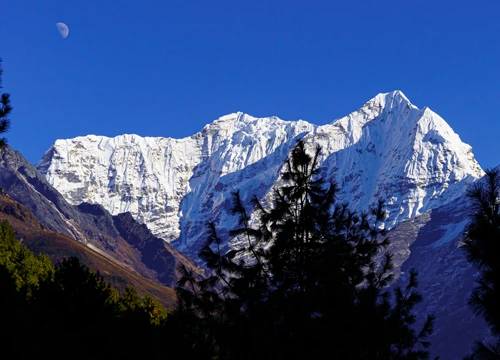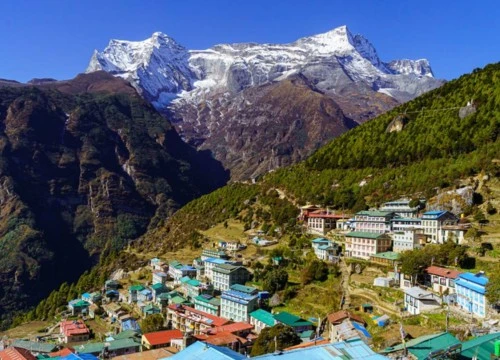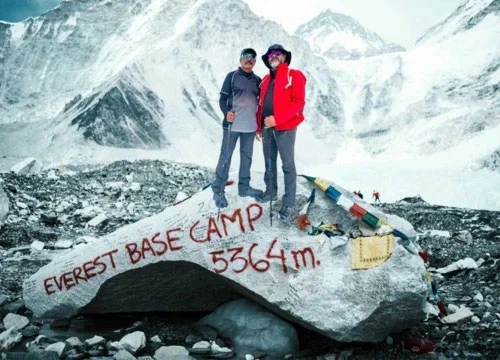Introduction: Everest short trek and Gokyo helicopter tour
The Everest short trek with the Gokyo Helicopter tour is one of Nepal's most fantastic adventure destinations. The Everest trek with Helicopter tour is located in the Solukhumbu district of Nepal, home to the highest mountain peak in the world known as Mount Everest (8,848.86 m /29031 ft) or Sagarmatha in the local language.
The Gokyo helicopter tour with the Everest trek is a fantastic opportunity to view the landscapes and landmarks of the Himalayan region of Nepal. The blend of the short trek and helicopter tour allows individuals to view natural marvels up close and from a bird's-eye view. The snow-capped mountains, including Mt. Everest (8,848.86 m /29031 ft), Pumori (7,161m/ 27,494 ft), Ama Dablam (6,812 m/22,349 ft), Nuptse (7,861 m/25,791 ft), Lhotse (8,516 m/27,940 ft), Lobuche (6,145 m/20,161 ft), Island Peak(6,165 m/20,226 ft), and many more, can be seen through walking as well as through the helicopter tour.
The Short Everest trek with Gokyo Lake helicopter tour takes individuals to some prominent villages of the Everest region, including Lukla, Phakding, and Namche. The short trek, which lasts up to Namche, also known as the "Gateway to Everest," allows individuals to explore the landmarks through walking. It also provides an opportunity to understand Everest's prevailing culture, traditions, and customs. Also, travelers get a chance to interact with the local sherpa people to understand better the mountaineering and trekking history of the Everest region, as well as information regarding the way of life of the sherpa people.
The helicopter tour allows for an aerial exploration of the area in and around Everest, with the ease of landing at the tranquil Gokyo Lake. Similarly, the Gokyo lakes at 4,700–5,000 m (15,400–16,400 ft) above sea level is a remarkable highlight for the helicopter tour. The Everest short trekking with Gokyo helicopter tour allows individuals to omit the strenuous walking in the higher elevations and substitute with a more comfortable helicopter tour.
The tour allows individuals to land alongside these oligotrophic lakes at the Sagarmatha National Park. Gokyo lakes in the Gokyo Valley add an extra layer of beauty to the Everest short trip. The crystal-clear water originating from the glacier and surrounded by the backdrop of mountain peaks is the major highlight of the Everest trek with the Gokyo tour.
As mentioned above, the Everest Gokyo Helicopter Tour lies under the Sagarmatha National Park, thus enabling visitors to see exotic flora and fauna that thrive in the Everest region. Some of the wildlife found in the national park are Himalayan Tahr, Musk Deer, Red Panda, Snow Leopard, Himalayan Black Bear, Blue Sheep, Himalayan Marmot, Himalayan Monal, and many more. Himalayan Griffon, Tibetan Snowcock, Spotted Nutcracker, Grandala, and Golden Eagle are some of the exotic avians found in the Everest region.
The Gokyo Everest Helicopter tour can be done all year round by a wide range of age groups with essential physical fitness. Spring and autumn are the best seasons for the 6-day Everest Short Trek and Gokyo Helicopter Tour; however, it can be done in all seasons with good weather conditions. With that in mind, it is also necessary to understand that visitors require specific permits and documents to enter the protected area of Everest.
Thus, one of Holiday Tours Nepal's most daring trekking packages is the Customized Everest Short Trek with Helicopter tour. So, gather your friends and family for an unforgettable journey where you will experience the majesty of Everest Base Camp from above the clouds, surrounded by views of jaw-dropping panoramas.
How does the Everest short trek with Gokyo helicopter tour start and end?
The Everest trek and Gokyo Helicopter tour starts with a domestic flight to Lukla from Tribhuvan International Airport of Kathmandu. The flight lasts 25 minutes and lands at the Tenzing Hillary Airport of Lukla.
Upon landing, the official trekking begins. The walk from Lukla moves towards Phakding, a prominent sherpa village in the Everest region. After Phakding, the trek moves towards Namche Bazaar, which is also known as the "Gateway of Everest." Namche, located at 3,440 meters (1,290 feet), is suitable for acclimatization and exploration. Various activities can be carried out in and around Namche, including the hike to Everest View Hotel, an excellent activity for spending the acclimatization day in Namche. Similarly, other activities include a trip to Sagarmatha Next, Irish Pub, Saturday Market, and many more.
After a well-spent day in Namche Bazaar, the Everest Short Trek is completed, and the Gokyo Helicopter tour commences. The helicopter tour begins from Namche and takes passengers around the Everest region with a view of Gokyo Lake. The helicopter lands beside the Gokyo Lakes, where individuals will spend some time looking at the pristine glacial lake with a backdrop of Himalayan peaks. The aerial tour offers views of Gokyo Ri (5,357 m /17,575 ft), Renjo La Pass (5,360 m/17,560 ft), Ngozympa Glacier, and other stunning vistas like Mount Everest, Cho Oyu, Lhotse, and many more. After spending time in Gokyo Lake and clicking photographs, the helicopter returns to Lukla. As the helicopter lands, Lukla passengers can have another day to explore around Lukla. The following day, trekkers on a Short Everest Trek with a Gokyo Helicopter tour return to Kathmandu through a flight from Lukla, marking the journey's end.
Everest short trek with Gokyo helicopter tour - 6 days altitude and distance chart
Day | Activity | Altitude (m/ft) | Distance (km/miles) | Duration (hours) | Elevation Gain/Loss |
01 | Arrival in Kathmandu and transfer to the hotel. | Arrival: 1,350m/4,430ft | — | — | — |
02 | Fly to Lukla and trek to Phakding. |
2,860m/9,383ft 2,610m/8,562ft | ~7.4 km / 4.6 miles | ~3-4 hrs walk | +1,210m / +3,968ft (flight) |
03 | Trek from Phakding to Namche Bazaar . |
3,440m/11,286ft | ~11.5 km / 7.1 miles | ~5-6 hrs walk | +830m / +2,723ft |
04 | Rest and explore Namche Bazaar, including a hike to the Everest View Hotel . |
3,440m/11,286ft | ~4 km / 2.5 miles (hike) | ~2-3 hrs hike | +440m / +1,443ft (hike) |
05 | Helicopter tour of Gokyo and return to Lukla. |
4,800m/15,748ft | ~20-25 km / ~12-15 miles (flight) | ~2 hrs (total) | +1,360m / +4,462ft (flight) |
06 | Fly back to Kathmandu. |
1,350m/4,430ft | ~138 km / ~86 miles (flight) | ~30 min (flight) | -1,440m / -4,724ft (flight) |
Why is Everest short trek with Gokyo helicopter tour special?
The Short Trek to Everest with Gokyo Helicopter Tour allows individuals to savor the highlights of the Everest region in a short time and effort. The Everest Gokyo Trek is marked as a strenuous activity and requires a high level of physical fitness.
However, the Everest Trek combined with the Gokyo Helicopter tour is an alternative option for those who do not want to take on the hectic walk but instead wish to travel comfortably. Here, travelers can visit the Everest region by helicopter ride, thus allowing a wide range of individuals to have families with children or older people.
Similarly, combining a short trek with a helicopter ride provides an opportunity to blend excursion through a short trek and sightseeing through a helicopter ride. The helicopter ride offers a sense of luxury for individuals while soaring above the mountains in a thrilling and adventurous ride. Similarly, the short trek provides an opportunity to look at the area, explore the landscape, and feel the Everest region's culture, tradition, and hospitality.
On the other hand, adding the Gokyo Heli tour with Everest Trek saves time and effort and has a positive impact on the environment. As the helicopter tour reduces the number of trekkers on the trekking trails, the carbon footprint associated with long-distance travel is reduced.
Finally, individuals on the Everest Trek with Gokyo Lake Heli Tour have less chance of getting acute mountain sickness (AMS) as the highest walking destination is Namche, with a full day left for acclimatization. Similarly, the helicopter tour poses less threat to AMS, making it a suitable trekking package bearing minimum to zero risk of altitude sickness.
For whom is the Everest short trek with Gokyo Lake heli tour perfect?
The Everest short trek with the Gokyo Helicopter Tour requires some physical fitness while walking from Lukla to Namche. So, it can be done by individuals or age groups who can walk at least five hours per day. Similarly, the following points summarize the suitability of Trekking to Everest with the Gokyo Lake helicopter Tour.
- Individuals who wish to explore the Everest area with minimum walking effort in the rugged Trans-Himalayan region of Nepal.
- Adventurers who wish to take a unique approach to reach Everest and Gokyo Lake in the Khumbu region.
- Wildlife enthusiasts are searching for exotic flora and fauna in the Sagarmatha National Park and Khumbu area.
- People are interested in acquiring information regarding the Sherpa community's lifestyle, culture, traditions, customs, and festivals prevailing in the Everest region.
- This trekking package is ideal for photographers, vloggers, cinematographers, and content creators who wish to capture the breathtaking landscape, recognizable landmarks, diversity of cultures, exotic creatures and birds, and the unspoiled beauty of nature.
- The Gokyo Helicopter Tour with Everest Trek is for first-time trekkers who do not have prior expertise in trekking and want a subtle travel package that does not require heavy walking.
Local culture and tradition in the Everest region
The Everest region is predominated by the Sherpa community, identified by their historic trekking and mountaineering expertise. Similarly, the Sherpa people thrive in prominent villages like Lukla, Phakding, and Namche. These people live in extreme climatic conditions, and the Sherpa community's primary occupation is assisting climbers in summiting the mountains.
As Sherpas are the locals of Everest, the region is dominated by Sherpa culture, tradition, and customs. Along the Everest Short Trek and Gokyo Helicopter route, mani walls encrypted with mantras and chants can be seen. Prayer flags and prayer wheels surround the mani walls. Similarly, various chortens, stupas, and gompas can be seen all along the Everest trekking route.
Similarly, the Everest region portrays the temples, stupas, sculptures, and shrines resembling Buddhism. The existence of the Tengboche monastery and the Pangboche monastery in Pangboche is proof of the dominant Buddhist religion in Everest. Similarly, the Mani Rimdu festival, sometimes referred to as a trekking festival, is the primary celebration for the inhabitants of Everest. Held in Tengboche monastery, the 19-day celebration commemorates the establishment of Buddhism by Guru Rinpoche Padmasambhava. It features mask dance, cultural shows, and a sampling of delectable regional fare.
On the other hand, the Sherpa culture provides its guests with a high level of hospitality. Trekkers are invited to tea houses, lodges, or any other type of lodging with the utmost respect and hospitality. This gives the community a chance to join together for ceremonies, get-togethers, and work, which strengthens their sense of solidarity.
Thus, the Everest region is rich in culture and tradition. Respecting the culture and following community guidelines during a visit to Everest is recommended. However, there can also be confusion regarding the culture and tradition. In that case, the guides provided by Holiday Planner Nepal, who are native to the region, can help to navigate the scenario.
Which is the best season or time for Everest short trek with the Gokyo Lake heli tour?
The Gokyo Helicopter Tour and Everest Short Trek can be done all year round. However, spring and autumn are the best seasons to go on the Everest Short Trek with the Gokyo Lake Helicopter Tour. The spring and autumn seasons are also known as trekking seasons in Nepal.
While the Gokyo Everest Trek should be done with ease and minimum challenge, the Gokyo helicopter tour should be done in clear weather conditions. For this reason, traveling in spring and autumn is the best possible time to get the ultimate experience.
Spring, which lasts from March to May, is one of the best times for an Everest Trek. Spring months in Everest are marked by blooming rhododendron forests, which add vibrant colors to the atmosphere. Similarly, the spring months have moderate temperatures, allowing for comfortable walking. The average temperature of the Everest region on spring days ranges from zero to six degrees Celsius, while it can drop to -8 to -10 during the night.
On the other hand, the autumn season in Nepal lasts from September to November. Autumn season is also the best season for Everest trekking. The autumn months are marked by clear skies and moderate temperatures, which allows for a comfortable walking experience. The Gokyo Helicopter tour in autumn will be a wonderful experience due to the clear blue skies that portray the birds-eye view of Himalayan landmarks in an auspicious manner. The average day temperature of the Everest region during autumn ranges from 9 to 17 degrees Celsius, and the night temperature can drop to 5 to -14 degrees Celsius.
Even though spring and autumn are the best months to travel to Everest, trekking can also be done in the summer and winter months. The summer months, which last from June to August, are marked by heavy rainfall and scorching weather. Similarly, the winter months from November to February are marked by frigid temperatures and snowfall.
The summer and winter climates make it difficult to view the mountain peaks, and harsh climatic conditions make it difficult to walk. The monsoon rain and snowfall make the trail slippery, causing problems. So, these extreme seasons suit hardcore trekkers who wish to take on a challenge.
Note: As the summer and winter seasons are considered off-season for trekking, those who intend to trek during this period must enquire at Holiday Tours Nepal before embarking on the route because of the extra preparation and precautions required.
Permits required for Everest short trek with Gokyo helicopter tour
The Everest region is considered a protected area by the government of Nepal. For this reason, special permits and documents are required by foreigners as well as locals to enter the Everest region. The licenses and documents needed for Short Everest Trek with Gokyo Helicopter Tour are as follows:
Khumbu Rural Municipality Permit
The Khumbu Rural Municipality Permit for foreigners, including those from SAARC countries, is NPR 2,000 per person for the first four weeks. For additional days after the first four weeks, the cost becomes NPR 2,500 per person.
Individuals can get the permit from the check post counter located at Lukla or Monjo. There are no alternative offices available in Kathmandu. Similarly, the representative from Holiday Planner Nepal can help get this permit along the trek.
Sagarmatha National Park Entry Permit
The entry fee for Sagarmatha National Park entry is given below:
- For Foreigners: NPR 3,000 per person
- For SAARC nationals: NPR 1,500 per person
- For Nepalese: NPR 100 per person
Trekkers can purchase the permit at Monjo and Kathmandu. Once all the necessary documents to obtain the permit are submitted, a Holiday Planner Nepal representative can help them obtain the permit from Kathmandu. This will enable a hassle-free purchase of the entry.
Note: In addition to the abovementioned price, 13% VAT is added to the permit purchase. Similarly, children under ten do not require a permit.
Chances of altitude sickness in Everest short trek with Gokyo heli tour
The highest altitude for the Everest short trek is Namche, which is 3,440 meters/11,290 feet. While the elevation above Namche is covered by a helicopter ride, there is less chance of acute sickness during the Gokyo Helicopter ride with the Everest short trek.
Acute mountain sickness (AMS), or altitude sickness, is caused by rapid ascent at the decreased oxygen level at higher altitudes without proper acclimatization.
Signs and symptoms of Acute Mountain Sickness
- Dizziness/headache
- Nausea and vomiting
- Tiredness and Fatigue
- Exhausted yet unable to sleep
- Loss of appetite
- Anger and Stress
- Shortness of breath
- Swelling of hands, face, and feet
Prevention of Acute Mountain Sickness
- Make a slow, unhurried rise to give your body time to adjust to the lower oxygen level.
- Consume a lot of liquids to avoid becoming dehydrated. Avoid alcohol, cigarettes, and caffeinated drinks to prevent dehydration.
- Steer clear of excessive fatigue and strenuous exercise. After resting, progressively climb to a greater altitude.
- Get a balanced diet that gives you the energy required for altitude adaptation and drinking enough water.
- If AMS symptoms appear, quickly check with the guide and drop to a lower altitude.
Is travel insurance required for Everest trek and Gokyo helicopter tour?
Indeed, a short Everest trek and a helicopter trip require travel insurance. Purchasing travel insurance can help protect against unanticipated events, even though it's not needed. People should obtain their insurance from a licensed provider, as Holiday Planner Nepal does not offe travel insurance. Likewise, make sure you get insurance that covers the following policies:
- Trip cancellation and interruption
- Medical emergency expenses
- Lost, stolen, or delayed baggage coverage
- Travel delays or missed connections
- Emergency evacuation services
- Personal liability coverage
- Assistance with legal costs and damages
- Assurance against any unforeseen circumstances
Outline itinerary for Everest short trek with Gokyo helicopter tour
Day 1: Arrival in Kathmandu
Day 2: Fly to Lukla and Trek towards Phakding
Day 3: Trek from Phakding to Namche
Day 4: Rest and exploration day at Namche
Day 5: Helicopter tour of Gokyo and return to Lukla
Day 6: Fly back to Kathmandu


 General
General Upper Body
Upper Body Torso
Torso Lower Body
Lower Body Hands
Hands Feet
Feet Undergarments and Inner Wears
Undergarments and Inner Wears First Aid Kits and Medications
First Aid Kits and Medications Other Essentials
Other Essentials






